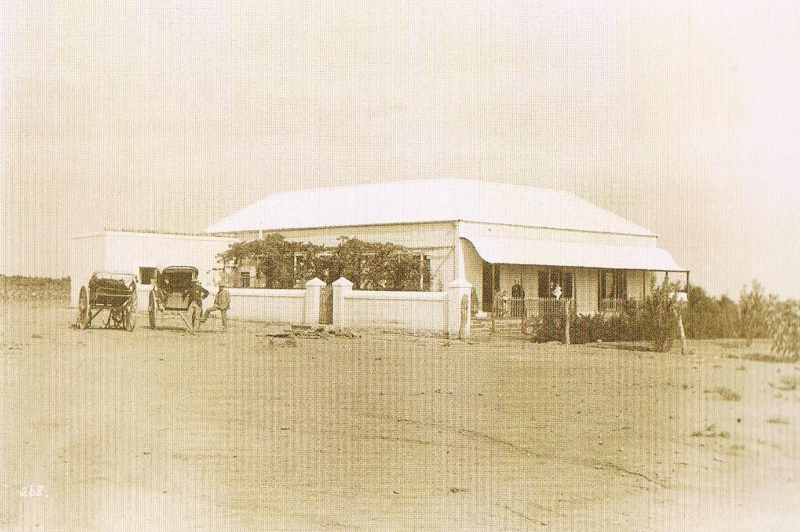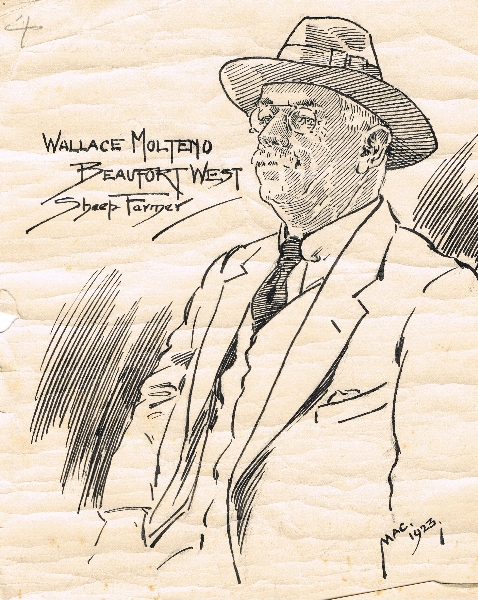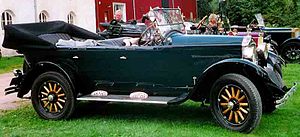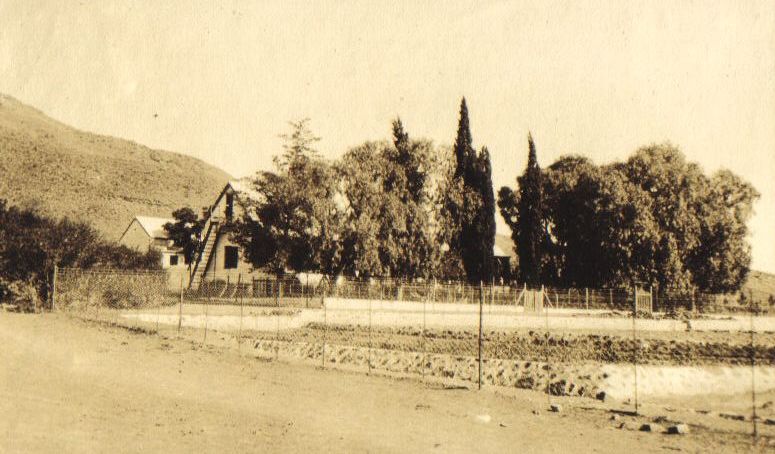Wallace & Lil Molteno move home from Kamferskraal to Nelspoort, Easter 1918
by Lil Molteno (nee Sandeman)
Source: Chronicle of the Family, Vol. 6, No. 2, August 1918
Introduction

Baakensrug near Nelspoort, one of the Molteno farms, 1890
Sir John Charles Molteno built up a number of neighbouring farms from the early 1840s when he first started sheep farming on the Karoo. They lay a few miles south of Three Sisters about 30 miles beyond the small centre of Beaufort West. The farms included Nelspoort (which was nearest to the rail halt from the 1870s), Kamferskraal, Mimosa Grove, Bleak House and at times one or two others. At their maximum, they covered some 70,000 hectares. To get a better idea of their size, this is some 270 square miles! Imagine in the days before the motor car riding on a horse 27 miles in one direction and then turning right for ten miles, and still being on what were his farms! When Wallace and Lil Sandeman married in 1907, they lived for eleven years at Kamferskraal before moving eventually in 1918 to the main farmhouse at Nelspoort where they spent the rest of their lives. What follows is Lil’s description of her family’s ‘Great Trek’ from Kamferskraal to Nelspoort. She tells the story in the third person.
Robert Molteno
May 2012
Wallace and his family are now settled in their new home at Nelspoort. The great trek took place in Easter week. Lil and the children arrived from Kalk Bay on Easter Monday and on the way down to Kamfers Kraal, stopped to inspect the alterations and additions to the Nelspoort house. They found the contractor, Mr Deas (who is also the local undertaker and has cultivated the appropriate demeanour for the part) in possession, with an army of workmen and the usual chaos, which the latter always manage to create around them — piles of shavings, pots of paint, pails of water, dust, dirt, etc. in all the rooms. Mr Deas proudly and gloomily displayed his handiwork, from the new wing to the large living room, 40 feet in length, where he had caused linoleum, of two different patterns, to be nailed down over the entire length and breadth, which feat he proudly announced had taken two men more than two days. He looked worse than funereal when Lil very kindly, but quite firmly, requested him to have it taken up again at once, as she intended to have the floor polished and adorned with rugs – evidently considering her quite mad when she might have good expensive linoleum.

Farm road from Kamferskraal to Nelspoort today
On the way back to Kamfers Kraal, after a thorough inspection, Lil pronounced herself much pleased with the work and said the house would evidently be ready for the furniture, in another week’s time. However, the man-of-wrath announced that the trek must take place next day, at latest, as the lambing sheep required his presence at Nelspoort immediately. As the family’s bread and butter, to say nothing of their jam, depends on successful lambing, there was obviously no room for argument; so next morning the wagons were piled high with furniture, while Lil, assisted by Miss Reynolds (Nurse) and the invaluable Mrs Fouche, feverishly packed books pictures, glass, crockery and silver in boxes, cases, wash-baskets and every, likely or unlikely receptacle available.
By lunch time the first loads were completed and the wagons rumbled off along the road to Nelspoort. Then a battle raged fiercely for some time, between the conflicting ideas of Man, as represented by Wallace, with Mr Wilmot in reserve, and Woman, represented by Lil, reinforced by Miss Reynolds and Mrs Fouche, as to the next procedure.

Wallace Molteno, Beaufort West sheep farmer — sketch, 1923
The opinion of Man was that the furniture should be moved straight into the house as it stood, after which it could be cleaned in a leisurely manner, while Woman flatly refused to move one chair or table into the house until it had been thoroughly scoured and cleaned from top to bottom.
It is not necessary to add that Woman, as usual, in matters of real moment, prevailed, and in consequence, the trusty Hup left the house an hour later with the following load: Wallace, bathed in the calm of resignation at the wheel, Lil beside him armed with a large apron and the wherewithal for making plenty of tea – at the back of the car, two trusty coloured ladies with their luggage, and food for two days, tied up in large pocket handkerchiefs, and all the babies, too young to be left behind, on their laps.
On the arrival of this strange assortment at Nelspoort, Lil marshalled her forces, having called up her reserves in the shape of more coloured retainers on the spot, with more babies, and having provided the adequate number of scrubbing brushes and pails (or paraffin tins where these ran short), brooms, mops, etc., the babies being disposed of under a tree in charge of the oldest baby! The army advanced on the position in close formation. The gloomy Deas was discovered lying on a bed of pain, having “most inconveniently” (to quote Wallace who was furious at the episode) fallen off a scaffolding that morning and hurt himself. In the absence of their general, his army of workmen fled in disorder at the approach of the invaders and the work began, and proceeded with such speed that the house was ready for the furniture by 11 a.m. the next day.

A 1924 Hupmobile, similar to Wallace and Lil Molteno’s older model
Wednesday was spent in moving in furniture and that night was the last at Kamfers Kraal and there were many sad hearts under its dear roof that night. On Thursday morning the wagons were loaded again, with all the beds and remaining furniture, and a very scratch lunch was eaten round a kitchen table, while everyone sat on chairs too old or decrepit to be moved up to Nelspoort. Then the elastic Hup was loaded to bursting point with all the things thought too fragile for the wagons,
such as the large portrait of Colonel Sandeman, and all the things that no one would part with til the last, and the toys that the children would not be separated from such as Aimee’s best doll and little Edward’s toy wagon. And when it was finished and all the things that had been forgotten crowded on, it was discovered that there was no room for the family! Mr Wilmot then nobly stepped into the breach (up to that moment he had been busily occupied in not getting in the way and pretending to like picnic meals with insufficient crockery) and offered his car and himself – which were gratefully accepted. The afternoon was spent in feverishly unloading the wagons and getting beds made up and everybody sorted into their new rooms before night, and by supper time the trek was a “fait accompli”.

The farm house at Nelspoort, c. 1914
The following week was somewhat chaotic, owing to the accumulated possessions of eleven years, having been hastily snatched up and dumped down in another house in three days, and everything having to be found and sorted into its new home. Days of continuous unpacking and arranging were followed by evenings of strained conversation with the doleful Deas and his carpenter, a Dutchman who was working in the house. Lil had mildly suggested that the latter might be entertained in the “outside room” but was squashed and informed that he was a very well-connected carpenter and would be hurt at such treatment. So she struggled vainly to keep the conversation away from coffins, which was Mr Deas’ favourite topic; the carpenter could not speak English and only opened his mouth to put food into it; and Wallace was of no assistance, as he vanished into the folds of the Cape Times, directly he finished his meal, and only emerged to say good-night.
However, everything comes to an end, even alterations to a house, and the happy day came when the last workman departed leaving only his rubbish heap to be cleared away, and the household settled down into its new home.

Nelspoort today — looking eastwards past the Cenotaph to Wallace Molteno and over the trees round the farmhouse
The additions to the house consist of three rooms opening out at a passage built on at the back of the house. The rooms face the north and the large windows make them very warm and sunny in winter. Two of the rooms are bedrooms and the room at the end of the passage is Wallace’s new office. It is a nice sized room, 16 by 12 feet, with a window, through which he can see any cart or wagon coming to the house along the road, and a door facing the other way, through which he can see the “boys” working on the lands. Now that Wallace has added the duties of J.P. [Justice of the Peace] and Field Cornet [in charge of the white farmers militia], to his farming labours, this outside door is a great convenience, as people coming only on business can go to the office without coming through the house.
The two front rooms which used to be a dining room and bedroom are thrown into one and make a very large and comfortable living room, with a big casement window facing north and another on to the stoep.
The stoep has been widened from seven to twelve feet and the green wooden railings replaced by a low white wall, on which stand geraniums and palms, and it is furnished with Madeira chairs and a couple of tables, and makes a delightful out of doors sitting room. The pepper trees make it impossible to have a garden in front of the house so that space is to be gravelled, while a garden is being made at the side of the house and Wallace has put in a dozen peach trees and a row of figs (there are apricots and plums there put in by Mr Jackson) and planted a rose garden – under protest! The water is not strong which makes gardening rather difficult at present. The only members of the family that have visited Nelspoort so far are Charlie and Victor Molteno, and Gwen and Eldred Bisset.
Explanatory Notes
- Kalk Bay was the tiny fishing village on the Cape Peninsula where Wallace and Lil owned a holiday cottage and where Lil and the children used to escape the heat of the Karoo summer and holiday by the sea. It is where my father, Donald, learned to swim and developed his lifelong love of False Bay.
- The Hupmobile was an American car, production of which had only started in 1909 a few years before the story told here.
- J.P. – Justice of the Peace; Field Cornet – officer in charge of the local white farmers militia.
- Charlie and Victor Molteno – two of Wallace’s elder brothers. Charlie had lived and farmed at Nelspoort previously to Wallace; Victor was a doctor. Both now lived with their families in Cape Town.
- Eldred Bisset. The Bisset and Molteno families are closely connected. Eldred was brother in law to Wallace’s nephew, Jervis Molteno, who had married Islay Bisset in 1916, a couple of years before this ‘Great Trek’. Eldred and Gwen lived in Cape Town.
